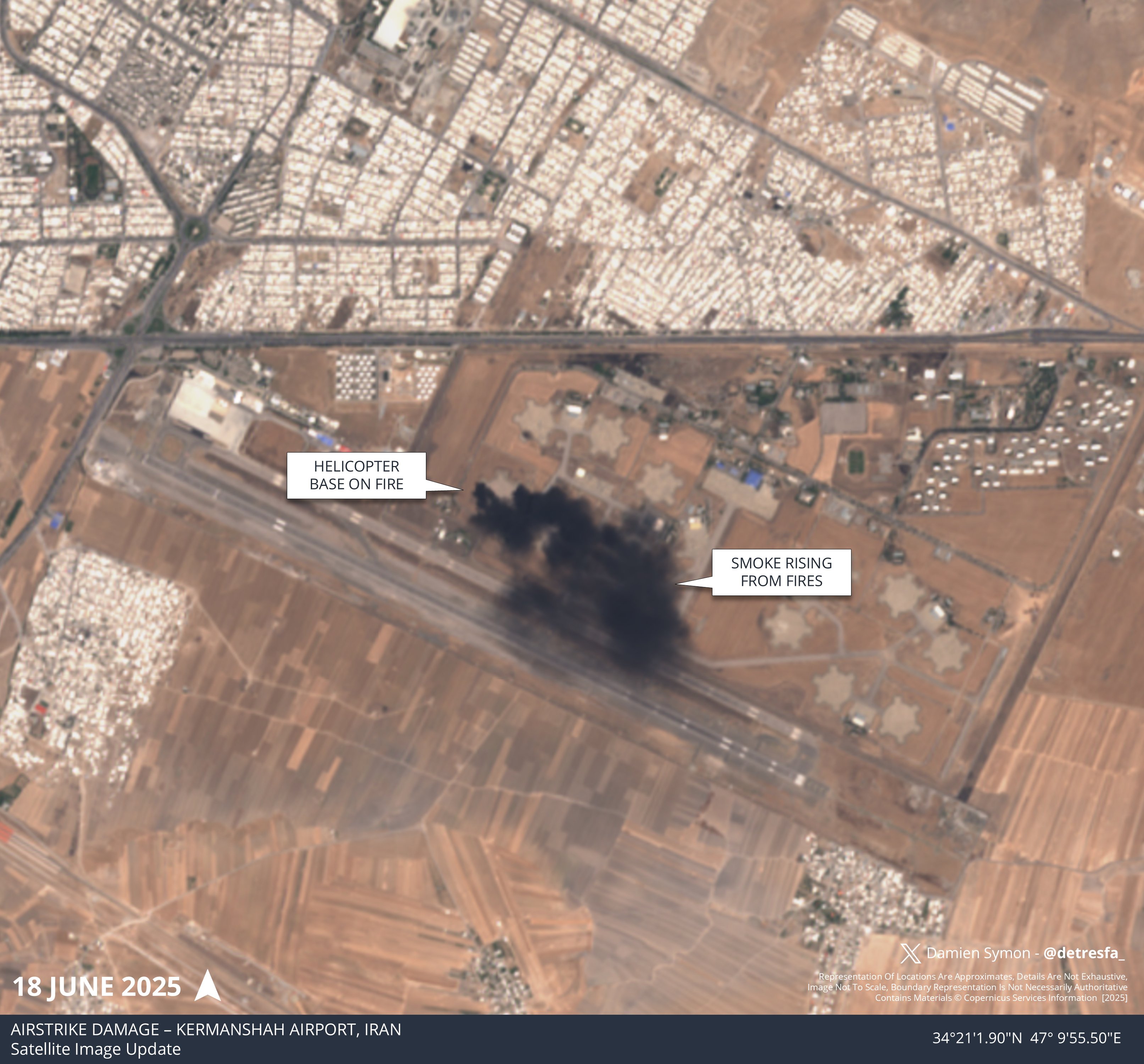
Over the past 36 hours, Israeli air raids on dozens of Iranian targets have continued.
Swarms of 50-60 F-15, F-16, and F-35 fighter jets, in addition to HERMES 900 and EITAN MALE UAVs, have eliminated targets in Tabriz, Tehran, Isfahan, and Kermanshah.
So far, more than 75 Iranian air defense missile systems have been destroyed, ensuring both Israeli air superiority over western Iran and the opening of corridors for the elimination of other targets located deeper inside Iranian territory (central-eastern).
Military sites in the Tabriz area were again heavily targeted. Specifically, a MIM-23B surface-to-air missile launcher from an I-HAWK medium-range air defense system and a KHORDAD system were eliminated, both hit by DELILAH-2 cruise missiles, as well as additional ballistic missile launchers and local base infrastructure.
The Isfahan area was heavily hit, where Israeli raids focused on the local air base housing the last 6/7 F-14A TOMCAT interceptor fighters still considered operational (the other 8/10 have not flown for months), although their withdrawal from active service was scheduled for the first half of 2025. The Ashoora garrison belonging to the 8th Ashraf Armored Division of the IRGC ground forces in Vila Shahr Najafabad near Isfahan was also hit, along with a logistics center, an oil refinery, and a warehouse located near the Morchekhort traffic police station (Shahinshahr province), which allegedly housed ballistic missiles, fuel containers, and oxidizers. The raids involved F-15I multirole fighters, one of which had to jettison at least one additional fuel tank to lighten the aircraft and maneuver adequately to evade one or more surface-to-air missiles. One of these, moreover, is believed to be responsible for shooting down a MALE HERMES 900 UAV east of Isfahan.
Several targets were hit in Tehran. Armed EITAN and HERMES 900 UAVs struck several air defense systems moving on the streets of the capital Tehran using MIKHOLIT air-to-surface missiles. The weapons and ammunition production facilities in Parchin and Lavizan (east of Tehran) were heavily bombed, as well as the Hemmat and Bagheri aerospace complex in Khojir, southeast of the capital, near the village of Hajarabad, known to be one of the largest ballistic missile production sites. A refinery, Imam Hussein University, the police headquarters in Rashid Yassemi, and a building belonging to the Ministry of Foreign Affairs in the northern part of the capital were also hit. In Mahdasht Karaj, on the northwestern outskirts of Tehran, the Fath air base, the main infrastructure of the IRGC Air Force, was heavily targeted.
As for Kermanshah, the IAF bombed the local air base, eliminating 8 AH-1J COBRA helicopters belonging to the 1st Assault Group. At least one HERMES 900 participated in the raid.
Finally, taking advantage of one of the aforementioned corridors, the Israelis also struck the Shahroud space center in northeastern Iran.
As mentioned, the bulk of the attacks focused on degrading Iran's remaining air defense capabilities and ballistic missile launchers. The progressive elimination of more than one-third of these has severely limited Iran's launch capacity for such vehicles, so much so that, compared to the first 3 days, the waves gradually decreased to 15/12 missiles (mainly EMAD and 3/4 FATTAH-1) in a maximum of two waves, over 90% of which were intercepted or ended up in uninhabited areas (according to official Israeli sources). The bulk of the launches took place from the Isfahan area, therefore from a position further inland in Iranian territory, requiring a range of at least 1,600 km, which limits the type of missiles that can be used mainly to liquid-fuel missiles, capable of covering longer distances but requiring longer and more visible preparation for launch. This hinders the tactic used by the Iranians over the last 2 days, when they realized they had lost almost a third of their transport and launch vehicles, which involves leaving the bunkers and quickly positioning 2-4 TELs, launching, and fleeing before the Israelis can reach and hit the TELs. Previously, dozens of TEL launchers were positioned simultaneously.
With regard to anti-aircraft systems, while long-range systems such as the S-300 and BAVAR 373, assuming the latter are actually operational, have been rendered inoperative by the elimination of early warning radars in western Iran, medium- and short-range systems are still active, albeit in progressively reduced numbers. Some—more than a dozen—have been moved from the missile bases they were protecting to the western part of the country, where they have been repositioned and their radars activated at random intervals to reduce the likelihood of detection by Israeli fighter-bombers and UAVs.
The Iranian Air Force is totally absent, considering that in 5 days there have been few reports of Iranian combat aircraft activity, dating back to the morning of the 13th (a MiG-29 from the 11th Squadron based at Mehrabad airport was seen flying over the capital for 15 minutes, while in the afternoon, a couple of F-4s took off from the Dezful base and flew over several cities in Khuzestan, and an F-5E was seen at low altitude over Ahvaz) and on the afternoon of the 17th, with the passage of an F-4E over Kermanshah and Tabriz. These flights were mainly demonstrative, intended to avoid discouraging the population and to demonstrate a residual capacity—fundamentally theatrical—for defense. However, no shoot-downs have ever been reported by the groups of 4/6 F-15A/D of the 133rd Squadron employed to escort attack packages or conduct armed patrols over western Iran (CAP) and “Siraq.” Currently, however, the Islamic regime is moving its VIP aircraft from Tehran to Oman to protect them from Israeli air strikes, with at least two A-321s landing in Muscat yesterday.
However, there are some factors that alleviate Iran's undoubtedly enormous difficulties. The first is that, despite official statements and various denials, Israel has suffered damage. Not as much as during the Iranian raids in the spring of 2024, but not zero either. Specifically, Mossad facilities and associated military units (Units 8200 and 9900) were hit, including the military intelligence complex in Gilot (north Tel Aviv), the Tel Nof and Nevatim air bases (which house key assets such as F-35s and KC-707 tanker aircraft), the Haifa refinery and power plant, as well as the surface-to-air missile sites defending the above facilities (certainly a DAVID'S SLING or IRON DOME in Haifa). A logistics center in Aman and a target in the Afula area were also hit, which, although not specified, caused secondary explosions and a large fire. In addition, last night, a FATTAH-1 ballistic missile struck the Lod area near Ben Gurion Airport, another struck an IRON DOME battery outside Netanya, while a third FATTAH-1 was reportedly intercepted over Tel Aviv.
The second, although not directly attributable to an Iranian success, is that there have been at least 4 confirmed cases of malfunctioning IRON DOME and/or ARROW 2/3 systems, during which the interceptor missiles crashed a few seconds after launch, causing unspecified but present damage to nearby structures. It is true that with such an impressive launch rate as that required to counter multiple warheads from Iranian ballistic missiles, some malfunctions are almost inevitable. But some doubts about the quantity of the stockpiles are beginning to emerge
Finally, in Iran, the IRGC and police are conducting a ‘manhunt’ to locate Mossad teams that are using drones and anti-tank missiles (ATGMs), and dismantling drone production laboratories, at least 3 of which have been discovered in Esfahan, Shiraz and Mashhad. At the moment, several Afghan and Iranian elements have reportedly been captured, mainly current or former members of the MEK, a left-wing Iranian terrorist group (based in Iraq) created to support Iraq during the war in the 1980s and which came under US control in 2003.
That said, in the next 24/48 hours, there may be a turning point in operations with the increasingly likely involvement of the US to ‘push’ Khamenei to surrender and/or definitively close the nuclear issue.
(Photo: satellite image of the Kermanshah base after the elimination of the COBRA helicopters; by Damien Symon on X)








.png)
